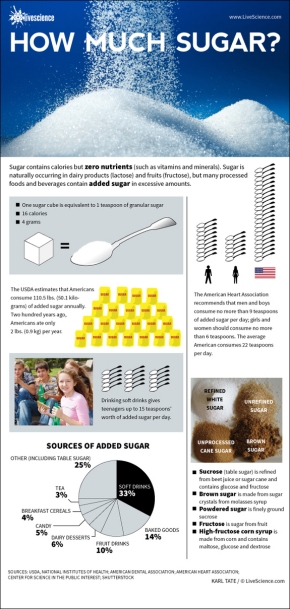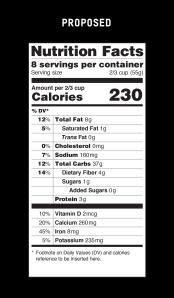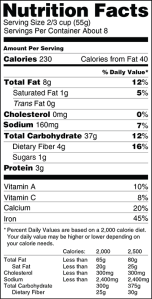Blog Archives
Hummus, the New Nutrient Rich Spread
No one knows for sure how far back the history of hummus goes, but traces of chickpea, the key ingredient, have turned up in Middle Eastern archeological sites dating to 7,500 B.C. Made from the few ingredients of chickpeas (garbanzo beans), olive oil, lemon juice and salt hummus is a delectable, creamy, irresistibly tasty spread. Seasonings are added to taste and can be used to make different varieties like roasted pepper, roasted garlic, or stick with traditional and sprinkle some cumin on top. The making of this dish is quite simple. All the ingredients are simply ground down until they form a smooth paste. These key ingredients come together beautifully and create a snack that is chock-full of nutrients that are linked to many health benefits.
 Hummus is a great sources of Omega 3 fatty acids, iron, and fiber. Beyond the nutritious benefits hummus is very satiating as well as rich in protein which helps you fight hunger cravings. “Food satiety” is the scientific term used to describe our satisfaction with food—how full it leaves us feeling, and how effective it is in eliminating our sense of hunger and appetite. Hummus can lower your risk of heart disease because it supports healthy cholesterol and blood pressure. These nutrients also contribute to better regulation of blood sugar.
Hummus is a great sources of Omega 3 fatty acids, iron, and fiber. Beyond the nutritious benefits hummus is very satiating as well as rich in protein which helps you fight hunger cravings. “Food satiety” is the scientific term used to describe our satisfaction with food—how full it leaves us feeling, and how effective it is in eliminating our sense of hunger and appetite. Hummus can lower your risk of heart disease because it supports healthy cholesterol and blood pressure. These nutrients also contribute to better regulation of blood sugar.
In a recent study, “two groups of participants received about 28 grams of fiber per day. But the two groups were very different in terms of their food sources for fiber. One group received dietary fiber primarily from garbanzo beans. The other group obtained dietary fiber from entirely different sources. The garbanzo bean group had better blood fat regulation, including lower levels of LDL-cholesterol, total cholesterol, and triglycerides.”
The base of hummus is garbanzo beans. Known by many names garbanzo beans are also commonly called chickpeas. The name “chickpea” can be traced back through the French chiche, Latin for ‘chickpea’. When found in the grocery store the name chickpeas and garbanzo beans are interchangeable, elsewhere there is subtle differences between the two. The beans found in grocery stores are usually cream-colored and relatively round, known at the “kabuli-type”. These beans come in many variety’s. World wide the most common type of garbanzo been is the “desi-type” which is smaller, irregularly shaped, and varies in color.
Hummus’ popularity is on the rise because Americans are seeking more “healthy” snacks. The sales of these types of spreads have gone up to $530 million in 2012, a 11 percent increase from a year earlier and a 25 percent jump over 2010, according to market-research firm Information Resources Inc. Grocery isles have been filling up with many different brands of pre-made hummus. Since this dish is so simply to make I highly suggest making it at home, which will also be more cost effective and you won’t have to worry about preservatives.
“Health Halo” Effect
As rates of overweight and obese Americans have reached record-levels, advertising claims have become more common on the fronts of food packaging, creating concerns that they may lead consumers to see foods as healthier than they really are (Brownell & Horgen, 2004; Nestle, 2002; Pomeranz, 2001). The effects of marketing can be significant because nutrition claims made on packaging can create “health halos” that make foods appear healthier than they are, leading to higher consumption yet lower perceived calorie intake. It is important to understand that influence of nutrition claims (e.g. “low fat”, “high fiber”) on health-related judgments and decisions. The effects of health claims on packaging is seen in a study done by Wansink and Chandon (2006) found that labeling both “healthy” and “unhealthy” food as “low fat” reduced calorie estimation by 20%-25%, and increased what was considered to be the “appropriate serving size” by 20%.
Chandon and Wansink introduced the “health halo” effect in 2007, referring to the findings that people tend to underestimate the calorie content of foods in restaurants where food choices are advertised as healthy, compared to restaurants that do not advertise a health image. One healthy attribute leads consumers to assume that foods offer other healthy but unclaimed attributes. Health claims on a product can produce a “halo effect” where consumers reported beneficial effects from the product beyond those specifically mentioned in the claim. This shows that the way consumers are processing the information they seeing on packages is far more complex than them simply processing it, they use their own beliefs and ideas and therefor interpret the information in a different way than it may be presented. For instance many consumers may mistakenly think that low fat equates to low calorie.
The mere presence of a low-fat claim has been shown to lead to underestimation of calories and greater consumption (Wansink and Chandon 2006). In a study products with a half-the-fat claim and half-the-calorie claim 22 percent of the participants made a positive “health halo” inference and thought the product was “healthy” or “good for you.” Though the study found that the products that claimed to be “better-for-you” tended to be “healthier”. But this is not to say that “healthier” is synonymous with “healthy”.
“Labeling snacks as low fat increases food intake during a single consumption occasion by up to 50%. This is robust across both hedonic utilitarian snacks, across young and old consumers across self-reported nutrition experts and novices, in public and private consumption, and regardless of whether people serve themselves or not” Wansink and Chandon 2006.
Studies by Wanskin and Chandon 2006 suggested that low-fat nutrition claims increase consumption because they increase perception of the appropriate serving size and reduce anticipate consumption guilt. “Health halos influence consumption because people feel that they can eat more of healthy food, or can eat more unhealthy (but tasty) food after eating healthy food without suffering any adverse health consequences” (Ramanathan and Williams 2007).
The effect that marketing can have on consumers purchasing habits is shown in Kellogg’s decision to market its first health claim. In 1984, Kellogg worked with the National Cancer Institute to endorse a health claim for All-Bran cereal, within six months the products market share increased by 47%. Kozup, Cyer, and Burton (2003) showed that “when a heart-healthy claim is on the package or menu, consumers generally judge the product to reduce the likelihood of heart disease or stroke, but favorable nutrition information lead to more positive attitudes toward the product, nutrition, and purchase intentions.” When unfavorable nutrition information is available, the heart-healthy claim has no influence on either the evaluations or disease risk perception.
This overall pattern results suggests that consumers may be somewhat wary of health claims and prefer instead to trust the information contained on the Nutrition Facts panel when it is available. Favorable nutrition information on Nutrition Facts panels have even stronger effects than health claims on product attitude and purchase intentions. Never the less, results showed that there were positive effects of the inclusion of a heart-healthy claim on a package or menu.
Marketers Use Words to Influce the Way You Think About Food
“[At] no point in US history have food products displayed so many symbols and statements proclaiming nutrition and health benefits.” The marketing that companies use on the front of their products in order to sell their goods is important because it reaches consumers at time of purchase and consumption. The amount of new food products, in 2000, that were marked “reduced/low fat”, 2,076 out of 16,890, had peaked at this time. There is a growing concern about nutrition and consumers wanting nutritional information on labels and they want more health food items conveniently available to them, found Nestle and Ludwig.
In the past years, marketers have become increasingly likely to make heavy use of nutrition claim (including “low fat”), health claims, and vague unregulated claims or health sales (“smart choice” or “good for you”). The words that marketers use to explain products can have a profound effect on consumer’s perceived nutrition of the food. There is a rise in the amount of foods claiming to be “better-than-you” because “the message that a food or food component is naturally and intrinsically healthy is one of the most appealing to consumers in all cultures” (Stone 2009).
Almost 70 percent of American adults age 20 or over the a were identified as overweight or obese. What makes obesity so relevant in this century? High body mass index (BMI) among children and adolescents has become and continues to be a major public health concern in the United States because it is the source of so many health issues. Children with high BMI often become obese adults, and obese adults are at risk for many chronic conditions such as diabetes, cardiovascular disease, and certain cancers. The key issue is that the majority of these diseases are preventable. But when people chose their food items, nutrition ranks last in a survey of the drivers of food choices, after taste, cost, and convenience.
This social issue trend can be traced all the way back to the grocery store and restaurants. When one walks down a grocery isle they are bombarded with a variety of products claiming to be healthy for them, whole grain, low-fat, low cholesterol, sugar free, fiber rich, the claims are endless. The decision to purchase processed food products differs from other purchasing decision. This is due to the fact that a health claim present of the front of packaging is typically encounter before nutrition information, which is usually present on the back or side panes, is processed.
Even when consumers are aware of the persuasive intent behind various marketing communication tools, they may not realize that their consumption decisions are being influenced, Chandon, Pierre, and Wansink (2012).
The effects that health claims can have on their perception of a food item can be shown just by the name of the food. The name of the food has a strong influence on how consumers’ expectations of how tasty, filling, or fattening the food will be, which are often uncorrelated with reality. For example, a study showed that branding the same food as a “salad special” versus “pasts special” or as “fruit chews” versus “and chews” increased dieters perceptions of the healthfulness or tastiness of the food as well as its actual consumption. Although, the name changes had no impact on non-dieters. This same effect of wording can be seen in again in that food is perceived to be leaner and higher quality when labeled “75% fat-free” than “25% fat.”
The effect of key words on packaging happens as well in other products who have health claims that do not specifically claim to be low-fat. Andrews, Netermeyer, and Burton (1998) show that consumers falsely infer that foods low in cholesterol are low in fat. Similarly, there is anecdotal evidence that some consumers erroneously believe that low-fat nutrition claim indicate fewer calories (National Institutes of Health 2004).
The effects of marketing can be significant because nutrition claims made on packaging can create “health halos” that make foods appear healthier than they are, leading to higher consumption yet lower perceived calorie intake. It is important to understand that influence of nutrition claims (e.g. “low fat”, “high fiber”) on health-related judgments and decisions.
Chandon and Wansink introduced the “health halo” effect in 2007, referring to the findings that people tend to underestimate the calorie content of foods in restaurants where food choices are advertised as healthy, compared to restaurants that do not advertise a health image. One healthy attribute leads consumers to assume that foods offer other healthy but unclaimed attributes. Health claims on a product can produce a “halo effect” where consumers reported beneficial effects from the product beyond those specifically mentioned in the claim.
The Nutritional Labeling and Education Act of 1990 (NLEA) establish criteria by which nutrient and health claims can be made on food packaging. Although health claims have been used on package labels since 1984, they have been criticized as vague, trivial, or misleading (Silvergald 1996). Although foods that are sold for immediate consumption, such as in restaurants, on airplanes, and from vending machines, are not covered by all aspects of NLEA.
Processed Foods Through the Years
Packaged, pre-made food products have not always been as abundant as they are today. The history of processed food has been directly affected by important moments of America’s history. Industrialization provided food processors the capability to mass produce, mass market, and standardize. This movement innovated the way meals were produced and gave way to the creation of processed, preserved, canned, and packaged a wide variety of foods.
Initially there were a few processed foods available in the early 1900’s like 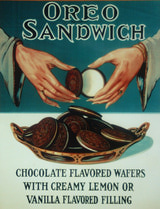 Oreos and Aunt Jemima syrup. Cereal was one of the first widely marketed “health foods”. In its original form the first cereal was made with a grain like wheat or rice and was similar to a corn flake with no added sugars. One of the major driving forces for ready-to-cook foods was war time. In conjunction with World War I canned and frozen foods became popular. Shortly thereafter processed foods began to take over the nations diet. Spam gained popularity because it was a perfect item to feed troops. More than 100 million pounds of SPAM luncheon meat are shipped abroad to feed allied troops during World War II. After World War II there was an increase in the supply of processed food items, therefore marketers needed to make a demand. Military research had brought about many new “convenience foods” like dehydrated juice and cake mix.
Oreos and Aunt Jemima syrup. Cereal was one of the first widely marketed “health foods”. In its original form the first cereal was made with a grain like wheat or rice and was similar to a corn flake with no added sugars. One of the major driving forces for ready-to-cook foods was war time. In conjunction with World War I canned and frozen foods became popular. Shortly thereafter processed foods began to take over the nations diet. Spam gained popularity because it was a perfect item to feed troops. More than 100 million pounds of SPAM luncheon meat are shipped abroad to feed allied troops during World War II. After World War II there was an increase in the supply of processed food items, therefore marketers needed to make a demand. Military research had brought about many new “convenience foods” like dehydrated juice and cake mix.
These new ways of preparing food was advertised to women as a means of liberating them from the kitchen, saving them time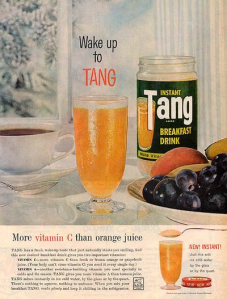 and giving them freedom to get out of the kitchen. By the 1960’s televisions and microwaves become popular and were found in many American homes. Products like Swanson TV dinners started to emerge alongside the rise of fast food restaurants. The amount of food dollars that were spent outside of the home rose sharply in the 1970s when more women joined the work force.
and giving them freedom to get out of the kitchen. By the 1960’s televisions and microwaves become popular and were found in many American homes. Products like Swanson TV dinners started to emerge alongside the rise of fast food restaurants. The amount of food dollars that were spent outside of the home rose sharply in the 1970s when more women joined the work force.
The 1990 Nutrition Labeling and Education Act (NLEA) required that all packaged foods include standard nutrition labeling information. The 1990’s also saw the mass consumption of caloric sweeteners.
The increasing amounts of meals that Americans ate from fast food restaurants and premade meals wreaked havoc on their waistlines. As response to this manufactures came out with new formulated products that were “low-fat,” “fat-free” and diet. The creation of low fat product lines was more about getting consumers to keep buying products and less about their health. Fat content was reduced by removing high-fat ingredients but the products still needed to taste good so artificial flavors and sweeteners were added in order to counterbalance the change as well as preservatives to extend shelve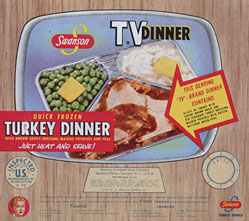 lives.
lives.
The amount of new food products, in 2000, that were marked “reduced/low fat” was 2,076 out of 16,890. Which had been a peak at the time. In the past years, marketers have become increasingly likely to make heavy use of nutrition claims (including “low fat”), health claims, and vague unregulated claims or health sales (“smart choice” or “good for you”).
In 2007 the recession had caused many people to begin to cook more foods at home and eat out less often. There is a growing concern about nutrition. About 80% of meals were prepared at home in November 2013, about the same as 2012, NPD data show. The percentage of meals prepared at home has risen steadily from 77.4% in 2008 at the beginning of the recession. Consumers want more health food items conveniently available to them. Popular movements such as the organic movement have caused consumers to question how and what our food is made of.
As an outcome of these movements “processed food” has become synonymous with unhealthy. But processed foods should not holistically be seen as bad. Products that are canned, frozen, or pasteurized can be very health. By freezing vegetables farmers are able to harvest them at their peak and we can have a consistent supply of fresh vegetables. There are also products that need to be processed for human consumption like oatmeal and coco-beans.
The Many Forms of a Oat
Oatmeal is very popular in the health community. It’s a great whole grain which offers many health benefits including it being a complex carb that is good for your cholesterol, rich in fiber, antioxidants, and great for your heart. I’ve mention before why I think everyone should be eating oatmeal for breakfast ,top it off with a bit of protein and its the true breakfast of champions. The breakfast aisle has a variety of packaged oatmeal’s like cinnamon roll, peaches and cream, apples and cinnamon, the varieties are abound. Stay clear from these instant oatmeal flavored packages all together, the best option is to and buy a container of plain oats. There is variety in plain oats too, which come in multiple forms. In order to pick out which one you want to cook with we must learn about the many from of plain oats (groats): steel cut, Scottish, rolled oats(regular or old fashioned) and instant. What are the differences between these form of oats and does the nutrition value vary?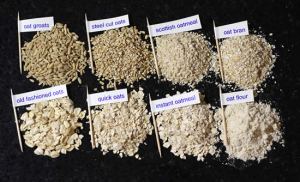
When oats are harvested: removed from the hull and stalked they are called a grain kernel, the the kernel gets broken down and depending on how processed the kernel the cooking time decreases. Once milled, where the outer shell (hull) is removed from the oats, oats are steamed, heated and cooled in a kiln, which brings out their nutty flavor. The oats are then processed by either being rolled, cut or ground to produce flakes, oatmeal or flour.
- Whole oat groats are the whole oat kernel that has had the inedible hull removed. These oats take the longest to cook at about one hour.
- Steel cut oats are cut into a few pieces by a metal blade, these take about 45 minutes to cook.
- Scottish Oatmeal is stone-ground , and the the kernel is crushed into multiple irregular pieces, a method that originated in Scotland centuries ago. The finer the oats the quicker they cook, these take about ten minutes.
- Rolled oats (old fashioned) are made by steaming the kernel and then rolling them into flakes. This process stabilizes their healthy oils and extends their self life, all without compromising their health benefits. During the steaming process the oat partially cooks, this allows the oat to cook much faster later on, generally about five minutes.
- Quick or instant oats, these oats have been rolled thinner so they will cook even faster.
Usually we view processed as a bad term, but when it come to oatmeal the degree in which the oats are processed does not affect their nutritional value. Steel cut, Scottish, old-fashioned, and quick oats are all made from whole grains and contain approximately the same amount of fiber, protein, calories, and other nutrients. Rolling the oats and then steaming them make it so that they can be cooked in just minutes. You should make you decision based on what type of texture you want your oatmeal to have, how much time you have to cook them, or weather you are using it in a recipe, which typically calls for traditional oats.
What Benefits does Orangic Food Offer?
According to the USDA Organic “is a labeling term that indicates hat the food or other agricultural product has been produced through approved methods that integrate cultural, biological, and mechanical practices that foster cycling of resources, promote ecological balance, and conserve biodiversity.” In order to be certified by the USDA no synthetic fertilizers, sewage sludge, irradiation, and genetic engineering can be used. Furthermore, to insure that you are purchasing organic food make sure there is a USDA organic seal in order to verify that the product is certified organic and has 95 percent or more organic content.
There is a whole assortment of terms used on labels like free-range, cage-free, grass-fed, pasture-raised, humane, no added hormones, and last but not least natural. Natural, as required by USDA, meat, poultry, and egg products labeled as “natural” must be minimally processed and contain no artificial ingredients. This regulation only applies to the processing of meat and egg products, and does not include any standards regrading farm practices. So that natural pasta sauce doesn’t really mean much of anything.
As long as the product is actually certified, we can feel secure that it has been produced in a better method than usual, but what about the food item itself. It wrong it assume that just because a food item is organic that it has better nutritional value. While there may be no significant nutritional difference between organic and conventional produce, organic does have lower levels of pesticide residue. “The published literature lacks strong evidence that organic foods are significantly more nutritious than conventional foods” a review done at Sanford University.
Everyone is taking a part of the rise of organic food. Walmart plans to partner with the Wild Oats organic products “a range of wallet-friendly organic food products” which cuts label prices by at least 25 percent compared to other brand-name organic competitors. Target is also expanding its partnerships with 17 natural and organic brands in order to expand its selection. Sales of products labeled natural and organic grew 7.5 percent in 2012, twice the overall growth rate of conventional food and nonfood products, according to the Organic Trade Association. Organic food accounted for $29 billion in United States sales in 2012, according to the most recent data, the Organic Trade Association said. Ten years earlier, its sales were $8 billion.
Microwaving Food
Today’s society is spending less time in the kitchen and eating more meals in restaurants. We live in a world of convince. Microwaves become popular in the 70’s and ever since we have been enjoying its ability to heat things in minutes. There has been skepticism of whether cooking with a microwave takes nutrients out of food.
Sources as varied as the American Cancer Society and the European Food Information Council—not to mention numerous studies—agree that these ovens are a nutritious way to cook.
In order to retain as many nutrients as possible one must wisely choose the way they cook their food. Microwaving is one of the best options to conserve nutrients. If you use a small amount of water your basically steam the food from the inside; retaining more vitamins and minerals than most other cooking methods. Whenever food is cooked there will be some loss of nutrients, in order to retain as much as possible the best method is to cook the food quickly, short exposure to heat, and a minimal amount of liquid. Just like a microwave would do.
Microwave ovens cook food with waves of oscillating electromagnetic energy that are similar to radio waves but move back and forth at a much faster rate.
The method of steaming can be equal to microwaving, if not better in some cases: One small study found that steamed broccoli retained more of its cancer-fighting sulforaphane than microwaved broccoli. Regardless some nutrients do break down when they’re exposed to heat, no matter the souce.
Nuts, Far More Than a Tasty Snack
The benefits of nuts are finally being recognized now that the anti-fat craze has passed. We now know better than to automatically cast aside a product because of its fat value. Today there is a clear understanding of fats and there types: “good” and “bad”. Nuts, contain unsaturated fat, protein, fiber, vitamins, minerals, and phytochemicals. What makes them such a great snack, are inexpensive and ready to eat, and easy to find. Not only are they tasty they are good for heart health, lowering cholesterol, and promote weight loss.
In 2003, the U.S. Food and Drug Administration authorized several nuts, including walnuts, almonds, peanuts, pine nuts, hazelnuts and pistachios, to be promoted as helpful in reducing the risk of heart disease and cholesterol problems. Walnuts stand out in particular because they are the only ones with omega-3s.
“When you look at the health benefits, I have to put walnuts at the top of that list because they are good source protein, good source of fats and they have a moderate amount of carbohydrates,” said dietician Connie Diekman of the California Walnut Board’s scientific advisory committee. Omega-3 fatty acids are also found in many kinds of fish, but nuts are one of the best plant-based sources of omega-3 fatty acids. Walnuts come out on top with their omega-3 values but all kinds of nuts are nutritious in any form regardless of plain, roasted, or a spreadable butter.
People who eat nuts as part of a heart-healthy diet can lower the low-density lipoprotein “bad” cholesterol level in their blood. Tree-nuts should be apart of your diet because they promote a healthy heart. Harvard’s report, in the New England Journal of Medicine, showed that daily nut-eaters were ‘less likely to die of cancer, heart disease, and respiratory disease. Overall, the daily nut-eaters were 20% less likely to have died during the course of the study than those who avoided nuts.”
Research now shows that eating tree nuts can help with weight management. As much as 80 percent of a nut is fat, don’t be scared it is unsaturated fat, “good” which is why nuts are heart healthy. A study released this past January confirms that consumption of tree nuts had a inverse relationship with weight gain. Researchers found that study participants who ate the most tree nuts – such as almonds, Brazil nuts, pistachios and walnuts – were between 37 and 46 percent less likely to be obese than those who ate the fewest tree nuts.
“Nuts are high in protein and fiber, which delays absorption and decreases hunger,” said Dr. Frank Hu, professor of nutrition and epidemiology at the Harvard School of Public Health, adding that nuts contain mostly unsaturated healthy fats. So you will be more satisfied if you eat a handful of nuts rather than some potato chips.
Nuts aren’t a magic pill in food form. In order to rep all of their benefits they need to be consumed proportionately, will little or no salt, and not coated in chocolate. Also they should be substitute for unhealthy fats, not cutting back on saturated fats found in many dairy and meat products won’t do your heart any good even if you eat a few nuts. If whole nuts aren’t your thing nut butters are great, but be picky when picking out your next jar of peanut butter. Many brands add sugar, molases, hydrogenated oil and other ingredients. The best peanut butter is made with only peanuts and salt, so be sure to read the nutrition label even if it says its natural and healthy. Remember sugar is natural and so are the oils they add. Finally, never ever by reduced-fat peanut butter, the high fat content is okay in the regular varieties because its unsaturated fat and they add even more junk into those poor reduced-fat jars.
Sugar
Sugar is found in many foods, whether its hidden away or prominently displaced as a marketing tool. It’s not unknown how alluring sugar is, but we’ve lost track of how much we are consuming throughout the years of the rise of convenience foods.
There are two types of sugar: added and natural. Foods containing naturally found sugar include fruit, fruit juice, milk and dairy products. Added sugar, as the name suggests is sugar that is added to food during processing or preparation to make it sweeter. There is a long list of ingredients that are classified as added sugar includes not just white table sugar, but brown sugar, honey, agave syrup, high-fructose corn syrup, molasses, and stevia. Just to mention a few food products that have a lot of added sugar include sugary drinks, cakes, candy, fruit drinks, bread, pasta sauce, chips and snacks, yogurt, and cereal.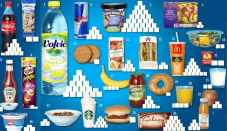
Sugar has a great influence on how our bodies perform. Jean Mayer, a Harvard professor of nutrition, is credited with discovering how the desire to eat is controlled by the amount of glucose in the blood and by the brain’s hypothalamus, both of which in turn are greatly influenced by sugar. Scientist are not the only ones who have looked into how sugar affects the brain, food manufactures have also learned how to use it to produce better, more tasty, and addicting foods. Food scientists can determine a product’s “bliss point,” – the precise amount of sweetness – that makes it most enjoyable.
The increasing amount of sugar Americans are craving may be turning into a learned behavior, the sweeter food is the sweeter we expect it to be. Throughout generations this produces kids who love sweet breakfast cereal, who grow up to desire sugar in their morning coffee, sugary salad dressing at lunch, frozen meals with sugar, topped off with a bowl of ice cream. As our taste becomes increasingly accustom to high amounts of sugar we start to unconsciously expect it.
With consumption at rates 22 teaspoons of it a day, the American Heart Association suggested in 2009 that Americans should cut their intake down to six teaspoons for adult women and nine for men. Although here is no specific national guideline for sugar consumption. Nor is there a recommended maximum limit for the amount of sugar food producers use unlike salt and fat. In 2004 when the WHO tried to include the 10% sugar limit recommendation in its Global Strategy for Diet, Physical Activity and Health, the U.S. Congress — under pressure from the sugar industry lobby — threatened to withdraw U.S. funding for the agency.
Sugar has come under fire previously in the late 70’s when the public became concerned about the amount of sugar in cereal and the FTC looked into regulating how TV advertising was aimed at kids. Some cereal’s clock in at 50 percent sugar. Soda consumption once was looked as the major culprit of the rising obesity numbers, but now the intake of other sugary drinks, like sports drinks, vitamin water, tea and others are just as bad.
Released earlier this year, this research is the first to link on a national level the amount of sugar American adults eat to their risk of dying from heart disease after taking into account weight, age, health, exercise and diet, said lead study author Quanhe Yang, an epidemiologist at the U.S. Centers for Disease Control and Prevention. “The risk of cardiovascular disease death increases exponentially as you increase your consumption of added sugar,” says the study’s lead author, Quanhe Yang, a senior scientist with the Centers for Disease Control and Prevention.
Consuming too much added sugar — in regular soda, cakes, cookies and candy — increases your risk of death from heart disease, according to a new study, the largest of its type.Excessive sugar is a big contributing factor to the obesity epidemic in America and other countries across the world. Weight gain is just the tip of the iceberg. Obesity is correlated with increased risks for even worse conditions including diabetes 2 and heart disease.
How can we curb our desire for sugar? Be conscious about the products were consuming, ultimately we are in charge of our health and can not be reliant on outside forces. Start with breakfast, the quintessential breakfast dish accounted for 31 percent of Americans’ morning meals, beating out eggs, bagels and other pastries, according to an ABC poll. Sugary drinks are also ill advised, even fruit juices like the beloved orange and apple, because the majority of nutrients and fiber and left behind when its sweet nectar is cultivated. We can’t expect food manufactures to be solely responsible for our health, they are in the business of making money and that is what they will do. It’s not that gloomy through. Campaigns are fighting for regulation and the lowering of additives. Also the new nutrition labels, which we wont be seeing for a few years, with address the issue of added sugars and more prominently display the amount of sugar a product contains.
First Look at Changes for New Nutrition Labels
The FDA made it its goal earlier this year, previous post Changes to Out Date Nutrition Labels, to update the 20 year old nutrition facts panel. The Nutrition Facts label was introduced in 1993 and since then the American diet has immensely changed. As the rates of obesity, as well as other public health problems, rise to drastic highs many have blamed the food products we consume. Michele Obama has been one of the leading voices for making a healthier America with the “Let’s Move” initiative.
What will the changes look like? Michael Landa said, “The proposed new label is intended to bring attention to calories and serving sizes, which are important in addressing these problems. Further, we are now proposing to require the listing of added sugars. The 2010 Dietary Guidelines for Americans recommends reducing calories from added sugars and solid fats,” director of the FDA’s Center for Food Safety and Applied Nutrition.
What will be different? Proposed vs old.
- emphasis and bold in some areas like calories & serving size
- no more calories from fat
- update Daily Values
- amount of potassium & Vitamin D will be required
- update serving size to reflect what is typically eaten
- & more
This proposal has not entered a 90 day public waiting period for comments. After the 90-day comment period, the FDA will issue a final ruling. They hope to complete that process within a year. Manufacturers will have 2 years to get the new labels on packages.

